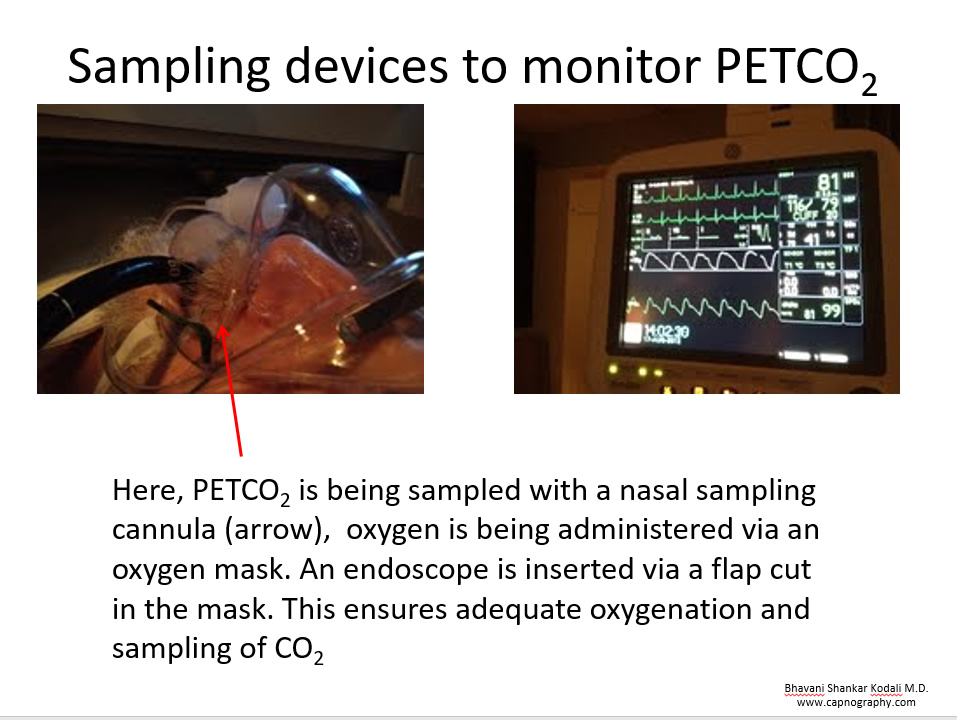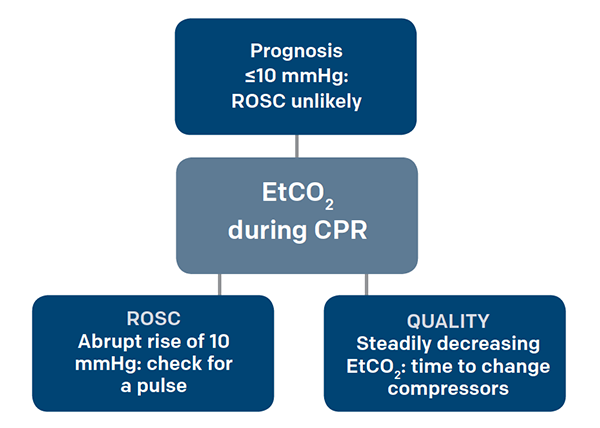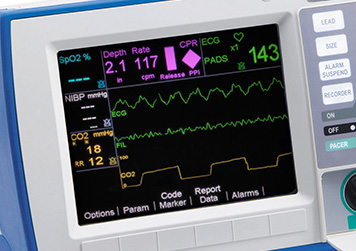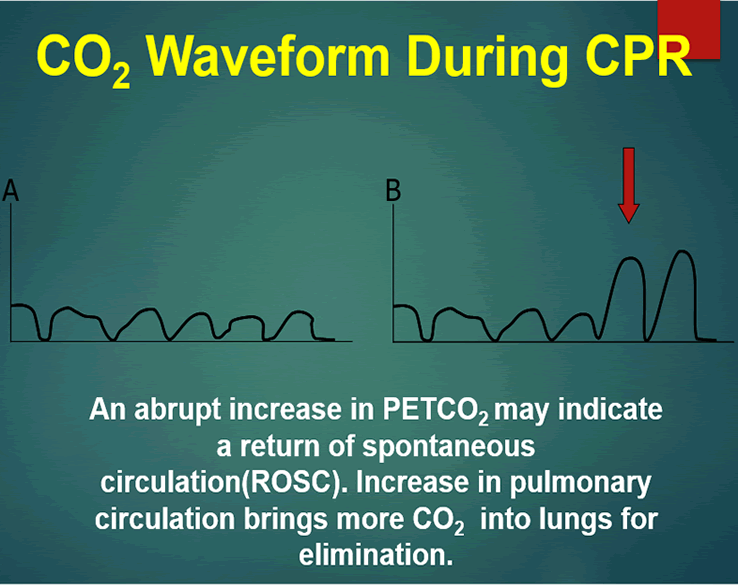end tidal co2 monitoring cpr
Remember the cells are going to use this oxygen create the CO2 but I still have to have adequate cardiac output a. This is exactly what were using end-tidal CO2 for in ACLS.
Emdocs Net Emergency Medicine Educationcapnography In The Ed Emdocs Net Emergency Medicine Education
More Than Just a Number.

. Also called capnometry or capnography this. What is end-tidal CO2 etCO2. Capnograph is an indispensable tool for monitoring metabolic and respiratory function.
Abrupt increase in ETCO2 suggests ROSC during CPR detectable. EtCO2 is a measurement of the partial pressure of CO2 in gas expired at the end of exhalation when exhaled gas will most closely resemble the. Does end-tidal carbon dioxide monitoring detect respiratory events prior to current sedation monitoring practices.
Association between prehospital cpr quality and end-tidal carbon dioxide levels in out-of-hospital cardiac arrest. Gradual fall in ETCO2 suggests compressionist fatigue during CPR - time to change compressionists. What should etco2 be during CPR.
The American Heart Association supports titrating the mechanics of cardiopulmonary resuscitation CPR to blood pressure and end tidal carbon dioxide ETCO2. Murphy RA Bobrow BJ Spaite DW et al. In the awake adult normal cardiac index lies between 25-4 Lminm2 with an ETCO2 of 35-45 mmHg.
Monitoring end-tidal CO 2 ET-CO 2 provides instantaneous information about. End tidal CO 2 monitoring is represented as a number. Acad Emerg Med 2006135004.
Most recent Advanced Cardiac Life Support ACLS guidelines now. End-tidal carbon dioxide ETco 2 monitoring provides valuable information about CO 2 production and clearance ventilation. End-tidal carbon dioxide ETCO 2 monitoring is readily available easily used and a standard of care in the operating suite and in the critical care setting.
End-tidal CO2 EtCO2 monitoring is a noninvasive technique which measures. McCarter T Shaik Z Scarfo K. Although the normal range for CO2 should be between 35-45mmHg CO2 monitoring gives healthcare providers a lot more insight into what is going on with a.
Loss of ETCO2 may be the first sign that CPR is needed. Correlation and agreement with arterial carbon dioxide. On average during CPR if adequate chest compressions are being.
When a capnometer is available and. Here are five things you should know about waveform capnography in cardiac arrest. Capnography continues to be an important tool in measuring expired carbon dioxide CO 2.
End-tidal carbon dioxide monitoring for weaning patients. The end-tidal carbon dioxide CO2 concentration has been found to correlate with cardiac output during and after cardiopulmonary resuscitation CPR in animal models. Multiple monitoring options so you can choose what and how to monitor respiratory status.
Association between prehospital cpr quality and end-tidal carbon dioxide levels in out-of-hospital cardiac arrest. NaHC03 will increase EtCO2 because it splits into CO2 and H20 So if rises after NaHCO3 do not. End tidal CO 2 monitoring is represented as a number and a graph on a monitor.
Although the normal range for CO2 should be between 35. It is a non-invasive practical method that measures carbon dio൸ide being expelled from the ET tube. Another method of monitoring the quality of the circulation and blood flow during cardiopulmonary resuscitation CPR is to measure the amount of carbon dioxide present in a.
Ad View a brochure to learn about end-tidal CO2 capnography. Normal ETCO2 in the adult patient. This will cause a decrease in the ETCO2 end-tidal CO2 and this will be observable on the waveform as well as with the numerical measurement.
The number is called capnometry which is the partial pressure of CO 2 detected at the end of exhalation. Two very practical uses of waveform capnography in CPR are. AHA recommends the monitoring of CPR quality utilizing ETCO2.
Multiple monitoring options so you can choose what and how to monitor respiratory status. In this study the aim was to review the applications of end-tidal carbon dioxide. Ad View a brochure to learn about end-tidal CO2 capnography.

3 Waveform Capnography Showing Changes In The End Tidal Carbon Dioxide Download Scientific Diagram

The Impact Of Ventilation Rate On End Tidal Carbon Dioxide Level During Manual Cardiopulmonary Resuscitation Resuscitation

Waveform Capnography Is A Commonly Used Monitor In The Operating Room And Is Increasingly Seen In Respiratory Therapist Student Icu Nursing Emergency Nursing
Effectiveness Of Cpr And Prognosis In Cardiac Arrest Capnography Training

The Role Of Etco2 In Termination Of Resuscitation Jems Ems Emergency Medical Services Training Paramedic Emt News

Etco2 Valuable Vital Sign To Assess Perfusion The Airway Jedi

Challenges Of Capnography During Sedation Capnography

Rogue Capno Waves Resuscitation Team Notes Unusual Waveform During Cpr Capnoacademy Capnoacademy

Etco2 Valuable Vital Sign To Assess Perfusion The Airway Jedi

Use End Tidal Capnography For Placing Orogastric Nasogastric Tubes And Cpr Page 2 Of 4 Acep Now Page 2

End Tidal Co2 Etco2 Capnography For R Series Zoll Medical

Quantitative Waveform Capnography Acls Medical Training

Pv Card Continuous End Tidal Co2 Monitoring In Cardiac Arrest

Nonin Respsense Ii Etco2 Monitor Respiratory Monitoring

Capnography During Cardiopulmonary Resuscitation Current Evidence And Future Directions

Cpr Mobile Code Stand With Capnograph Capnography

3 Waveform Capnography Showing Changes In The End Tidal Carbon Dioxide Download Scientific Diagram

Use Capnography For A Patient In Cardiac Arrest Capnoacademy Capnoacademy
